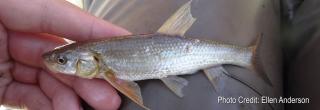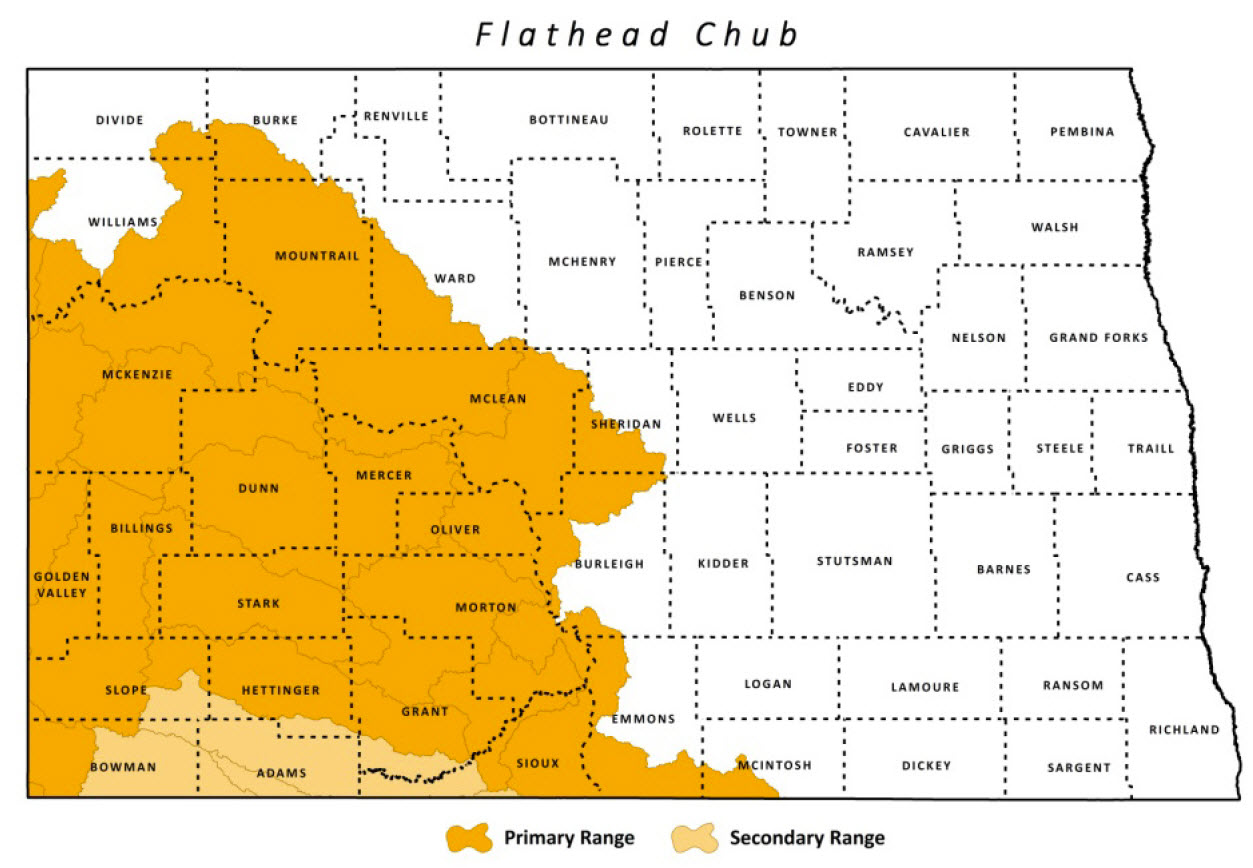
Flathead Chub
| Scientific Name | Platygobio gracilis |
|---|---|
| General Description | The Flathead Chub is a larger member of the Chub family, reaching a foot in length. It has a broad, flat head, tapering to a point. Its eye appears small compared to body size. Its color is dusky brown on top with silvery sides and has large sickle-shaped dorsal and pectoral fins. The first ray of the dorsal fin extends beyond last ray. It has a barbel in each corner of its mouth. |
| Status | Year-round resident. |
| Abundance | Uncommon, declining. |
| Primary Habitat | Found mostly in large turbid rivers with sand or gravel bottoms. |
| Federal Status | None. |
| Reason for Designation | A native species to North Dakota. Major declines over much of its range have been documented. Habitat loss is the main reason for this designation. Impoundment and channelization of the Missouri river system has changed the slow moving, warm, turbid water to reservoir habitat. Recent surveys failed to document it in the tributaries of the Missouri River. |
Locations and Conditions of Key Habitat
Preferred Habitat
Prefer slow turbid water such as is present in the upper Missouri and Yellowstone rivers in North Dakota. Found mainly within the main channel of these systems. Prefer water with a turbidity of less than 250 NTU (nephelometric turbidity unit). They can be found at most depths within this habitat, but prefer depths less than 1 meter with water temperatures in the range of 18°C to 22°C.
Key Areas for Flathead Chub in North Dakota
Populations occur in the Little Missouri, Yellowstone and upper Missouri rivers near the confluence. Many Missouri River tributaries such as the Knife, Heart and Cannonball rivers hold populations, although recent surveys have not documented them.
Problems Which May Affect this Species
Habitat
The loss of habitat caused by a change in the riverine regime is the largest problem affecting this species. Historically, Flathead Chub were present throughout the entire Missouri River System. The construction of dams and channelization has largely changed the river system. Dams have reduced the sediment load, in turn lowering turbidity. The release of cold water from impoundments has lowered the overall temperature of the system, making much of the Missouri River too cold for Flathead Chub. Dams have fragment populations by restricting movement. Flathead Chub now only occur in those areas that maintain qualities of the pre-impoundment system.
Other Natural or Manmade Factors
Competition and predation from nonnative fish that have been introduced into the Missouri River System impact Flathead Chub populations. The use of water for agricultural, industrial, and municipal purposes along the river has also impacted Flathead Chub populations.
Research and Survey Efforts
Current Research or Surveys
- Currently, there are no studies or surveys specifically targeting the Flathead Chub.
Previous Research or Surveys
- The biology of the Flathead Chub was studied in Montana in 1985 by Gould.
- Welker and Scarnecchia conducted a study on habitat use and population structure in 1997-1998.
Additional Research or Surveys Needed
- Information gaps concerning feeding habits, reproduction, seasonal habitat use, and other aspects of Flathead Chub biology need to be addressed.
- Develop a monitoring protocol for the Flathead Chub.
- Additional survey effort to determine current distribution.
Management Recommendations
- Protect rivers, streams, and riparian areas where possible (i.e. easements and/or acquisition).
- Work with partners to ensure Swampbuster provisions are maintained.
- Continue to use the Section 404 program to ensure affected rivers and riparian areas are mitigated to replace form and function.
- Continue to work with other federal agencies (i.e. FAA and FHWA) not covered by Section 404 or Swampbuster to ensure affected rivers and riparian areas are mitigated to replace form and function.
- Continue to work with NDSWC to develop minimum in-stream flow recommendations.
- Develop and promote incentive programs to restore riparian areas.
- Continue to work with ND 319 Task Force in prioritizing projects within impaired watersheds and implementing BMP’s.
- Develop and promote incentive programs for adjacent landowners to improve bank stability through land use changes (e.g. RRBRP).
- Promote non-traditional bank stabilization measures (i.e. root wads, willow waddles, vegetative slope).
- Implement intake conditions or recommendations (i.e. screening and velocity requirements).
- Work with the dam owners for potential removal or modification.
- Cooperate with Fisheries Division on state aquatic nuisance species plan.
- Survey areas of data gaps. Conduct research/surveys to establish baseline information on SCP.
- Continue to work with partners in promoting and distributing educational materials related to river, stream and riparian values and good stewardship.
Monitoring Plans
No monitoring plan has been identified for this species. The North Dakota Department of Health conducts Index of Biotic Integrity (IBI) surveys for all of North Dakota’s watersheds. This will document all species encountered.
2005-2015 Progress
The Flathead Chub maintains its Level II Species of Conservation Priority. The most recent survey of western stream fish did not document the flathead. Sites within their range need to be revisited to evaluate their status in the state.

Note: A listing of works consulted when compiling the information on this page may be found in the 2015 State Wildlife Action Plan.
